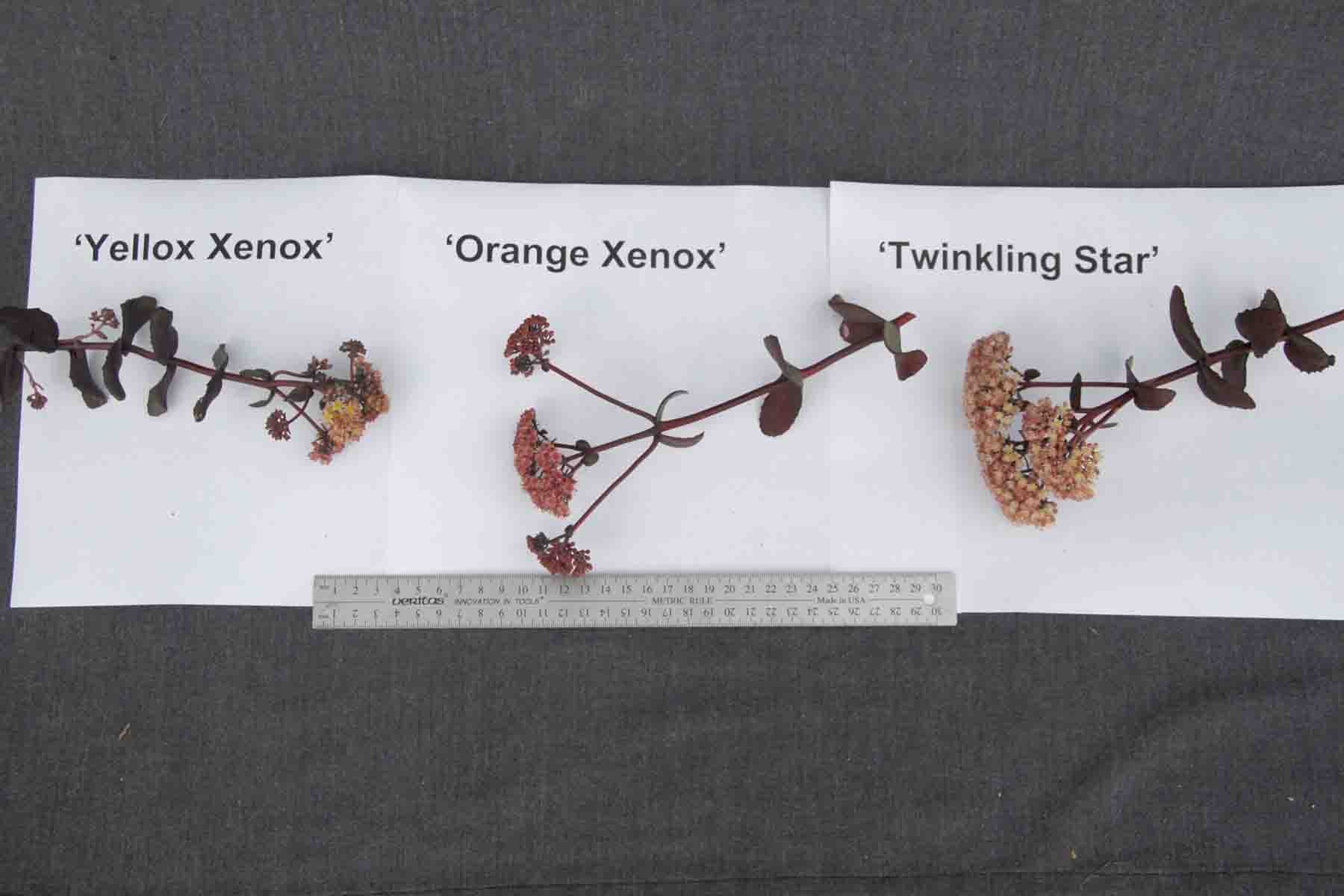Orange Xenox
| Denomination: | 'Orange Xenox' |
|---|---|
| Botanical Name: | Hylotelephium spectabile |
| Applicant/Holder: |
Future Plants Licentie B.V. Achter de Watertoren 11 2182 DV Hillegom Netherlands |
| Breeder: |
Hubertus Gerardus Oudshoorn, Rijpwetering, Netherlands |
| Agent in Canada: |
Variety Rights Management 475 County Road 18 R.R. #2 Oxford Station, Ontario K0G 1T0 Canada Tel: 613-258-9015 |
| Application Date: | 2011-01-27 |
| Application Number: | 11-7169 |
| Grant of Rights Date: | 2013-09-05 |
| Certificate Number: | 4616 |
| Date rights revoked: | 2018-09-05 |
Variety Description
Varieties used for comparison: 'Twinkling Star' and 'Yellow Xenox'
Summary: The plants of 'Orange Xenox' are taller than those of both reference varieties and wider than those of 'Twinkling Star'. The inflorescence of 'Orange Xenox' are larger than those of 'Yellow Xenox'. The secondary colour on the upper side of the petals of 'Orange Xenox' is brown purple while that on 'Twinkling Star' is light yellow brown and than on 'Yellow Xenox' is yellow.
Description:
PLANT: vegetatively reproduced, perennial, upright-bushy growth habit, medium branching
STEM: purple, strong anthocyanin colouration, absent or very weak glaucosity, absent or very sparse pubescence, medium thickness, smooth
LEAF: opposite arrangement, simple, ovate, acute apex, cordate base, dentate margin, absent or very sparse pubescence on upper and lower sides, absent or very weak glaucosity on upper side, dark green (RHS 144A-B) with brown purple (RHS 184B-C) anthocyanin colouration on the upper side, no variegation, no petiole
INFLORESCENCE: late flowering, medium to long flowering period, cyme, terminal position, erect attitude
PETAL: very open arrangement, few, small, elliptic, upper and lower sides light yellow brown (RHS 159C-D) to white (RHS N155D) with brown purple (RHS 185D) at base
Origin & Breeding History: 'Orange Xenox' originated from a population of seedlings created from the hybridization of 'Xenox' and 'Sunkissed' at Rijpwetering, The Netherlands in the summer of 2007. The new variety was selected in the summer of 2008 from the population of seedlings based on plant habit, flower form and foliage colour.
Tests & Trials: Trials for 'Orange Xenox' were conducted at Variety Rights Management in Oxford Station, Ontario during the summer of 2012. The trial consisted of 15 plants of 'Orange Xenox', 11 plants of 'Twinkling Star' and 11 plants of 'Yellow Xenox' with one plant per pot. The pots were 22 cm in diameter and were spaced approximately 45 cm apart. All colour determinations were made using the 2001 Royal Horticultural Society (RHS) Colour Chart.
Comparison tables for 'Orange Xenox' with reference varieties 'Twinkling Star' and 'Yellow Xenox'
Plant height (cm)
| 'Orange Xenox' | 'Twinkling Star' | 'Yellow Xenox' | |
|---|---|---|---|
| mean | 29.17 | 26.35 | 25.10 |
| std. deviation | 1.94 | 1.60 | 1.41 |
Plant width (cm)
| 'Orange Xenox' | 'Twinkling Star' | 'Yellow Xenox' | |
|---|---|---|---|
| mean | 28.33 | 24.50 | 28.50 |
| std. deviation | 4.13 | 2.88 | 1.91 |
Inflorescence diameter (cm)
| 'Orange Xenox' | 'Twinkling Star' | 'Yellow Xenox' | |
|---|---|---|---|
| mean | 11.07 | 10.72 | 8.42 |
| std. deviation | 1.23 | 1.64 | 0.97 |
Colour of upper side of petal (RHS)
| 'Orange Xenox' | 'Twinkling Star' | 'Yellow Xenox' | |
|---|---|---|---|
| secondary | 185D | 158B | 7D |
Click on image for larger view

Sedum: 'Orange Xenox' (centre) with reference varieties 'Yellow Xenox' (left) and 'Twinkling Star' (right)
Click on image for larger view

Sedum: 'Orange Xenox' (centre) with reference varieties 'Yellow Xenox' (left) and 'Twinkling Star' (right)
- Date modified: